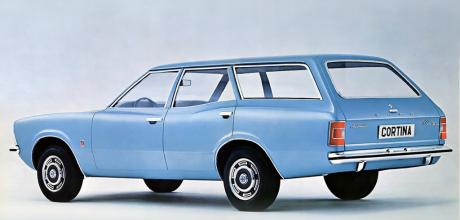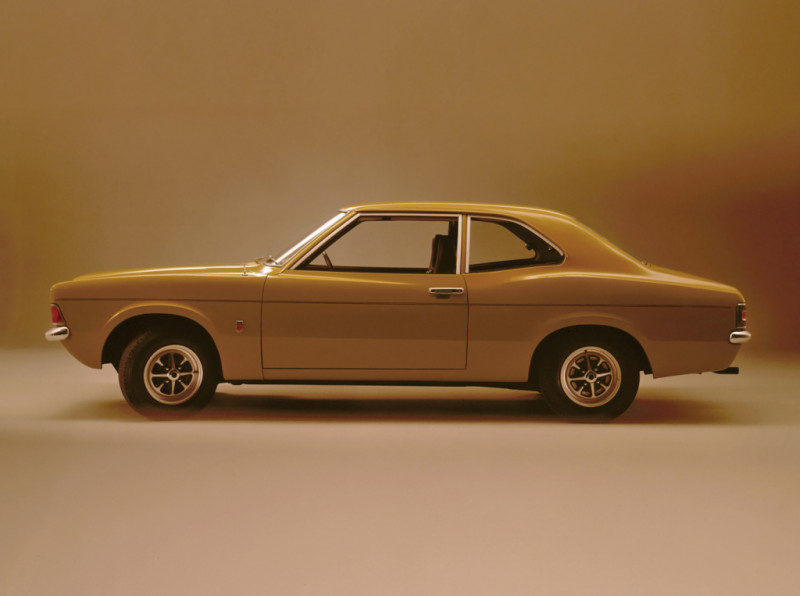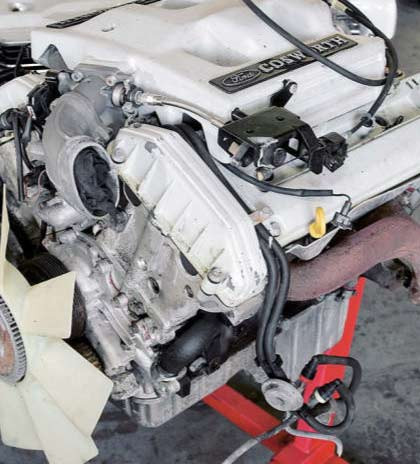Upgrade Guide Ford Cortina Mk3

Stylish and plentiful, the now-iconic Mk3 Ford Cortina has lots going for it. Here’s how to make it even better.
IMPROVING YOUR CLASSIC FORD JUST GOT EASIER
Ford MK3 CORTINA
UPGRADE GUIDE: Mk3 Cortina Get more from your Cokebottle Cortina without ruining its classic appeal with our fivepage tuning guide.
The shape of the Cortina throughout the years has always been a good reflection of the times in which they were made. Where previous Cortinas tended to be boxy and defined, the release of the shapely Mk3 at the start of the 1970s became an instant icon.

Its Coke bottle design wasn’t the only thing new to Ford either, as it was given an all-new platform and drivetrains, including the now-legendary Pinto for the first time. Due to the Mk3’s bigger-than-average size, softer ride and stylish exterior, it soon became popular as a cruiser rather than a racer, although that didn’t stop people shoehorning engines of all types in over the years. Sadly, the Mk3 didn’t enjoy the racing heritage of previous models, and there were no real high-performance models either, other than the Savage conversions. However, that’s not to say they can’t be given the performance treatment and as the legendary Pinto engine was standard fitment in some models, you won’t be surprised to learn that Cosworth YB power goes in with very little encouragement. Then there is the option to change the engine to something a bit meatier, like a 24-valve V6 for example.
Everything you need to know to update and uprate a Mk3 is in here, so let’s get to it.
BODY
The introduction of the Mk3 in the 1970s marked a new beginning in Ford car design as the boxy shape of the Mk2 was replaced with smooth and flowing lines that seemed to mimic American cousins. The iconic Coke bottle shape of the Cortina was something that really stuck in people’s minds as one of the designs of the era and they are good-looking even today. Its timeless shape is especially rare for a Ford in that it lends itself as well to the four-door shape as it does the two door, so there isn’t anywhere as near the amount of favouritism regarding which of the models is more desirable compared with other Ford siblings.

Although two-doors still fetch slightly higher premiums the cars are generally seen as cruisers and bruisers rather than stripped-out race cars, which is why the four-door tends to work as well from a comfort point of view. There’s a lot you can do with the stylish shape and we’ve seen many approaches over the years with muscle car colour schemes working well. For a more subtle look try and pick up a GXL model, which came with Rostyle wheels, a vinyl roof and a quad-headlamp package. As seen in retro cop drama Life on Mars and various adverts over the years they are ooze coolness, so it would be a crime to do anything but restore them. Chrome trim does still come up at places like autojumbles if you look around and most parts are still obtainable.
You can always try something different though, we would love to see a period Touring Car look with a pale colour and steels?
ENGINE
The infamous Pinto engine is well known for its tunability and the fact it came as standard fit in most Mk3s means it would be rude not to make the most of the combination — and it’s the 2-litre that you should aim for. If your car didn’t come with this, it’s not hard to get hold of one from a variety of Ford models over the years and they are not that expensive either.

There’s a difference in Cortina and Sierra heads in that the latter tend to be suitable for unleaded applications and so more preferable, but all 2-litre heads have large ports that allow for easy benefits to be had. The best standard fit carb is the Weber 32/36 DGAV twin-choke which is fine up to around 130 bhp or so. But it’s worth rejetting this carb or replacing it with a 38 DGAS from a 3-litre Capri, putting it together with a decent cam such as the Kent FR32 and slightly raising the compression ratio as that will see you over 145 bhp. But only as long as there is a good free-flowing exhaust and manifold, which is critical, and an Ashley system is more than suitable till around the 180 bhp mark.
For more power from there you need to jump straight to a set of twin 45s to see anymore gain, as anything smaller will restrict the big port head. If this is well set up with a Stage 2 head that includes bigger inlet valves and a better cam such as a Kent RL31 or similar you should see a solid 160 bhp or so. Beyond that will require a fair bit more work to maintain the bulletproof reliability of the Pinto. If you do want bigger power it’s normally worth starting off with the stronger Sierra blocks if you haven’t already. The 205 blocks have thicker casts and allow for safer reboring for increased capacity and are best suited for the 2.1 treatment.
Capri V6 pistons can be machined to fit and increase capacity with a rebore or you can buy suitable forged items that are direct replacement. The rods will need replacing in order for it to rev comfortably past 7500 rpm and a range of steel replacements are available in a variety of different sizes depending upon your intended capacity. Cranks are good to around 8000 rpm but YB cranks are a better bet at this level. For induction a pair of 48s or even 50s will be needed to supply the fuel and a better head with larger exhaust valves would be needed to see 200 bhp or more.
Electronic ignition is a worthwhile mod at any level but is necessary in higher states of tune.
Info
Contacts Aldridge 01902 710805 www.aldridge.co.uk Burton Power 020 8518 9127 www.burtonpower. com GAZ Shocks 01268 ?????? www.gazshocks. com GS Escorts 0151 4228333 https://gsescorts. co.uk John Brown Wheels 01926 817444 www. johnbrownwheels. com Kent Cams 01303 248666 www.kentcams.com Motomobil www.motomobil. com Rally Design 01227 792792 www.rallydesign. co.uk
ENGINE SWAPS
24-VALVE V6
This is a fairly straightforward conversion if you have the right bits as a lot of the parts from both the engine and car need no fettling at all. The sump and engine doesn’t need touched and neither does the crossmember as there are no clearance issues to deal with as long as the correct engine mounts are used. These will need to be V6-based Cortina mounts such as the Mk4 or 5 ones found in the 2.3-litre which need to be used with Capri 2.8i or Cortina items packed out by 6 mm to offer the same clearance as the larger Capri mounts.
Other mounting issues are towards the rear of the engine, where the right-hand cylinder head requires the heater box housing to be trimmed flat and the matrix moved to a new position. The chassis rail needs notching if you’re keeping the power steering, so it will require cutting and shaping in new metal.
“IT’S QUITE COMMON TO SEE MK3 CORTINAS SITTING ON MORE MODERNSTYLE WHEELS”
The radiator and bottom rad hose from a Mk5 V6 Cortina is a direct replacement and more than up to the job. For a top rad hose you can use a shortened Granada item and the header tank from something like a DOHC Sierra as it can be a tight fit.
Standard exhaust manifolds are an easy shape to match to a Cortina 2.3 V6 twin system. Wiring isn’t particularly hard on these cars but you may want to leave it someone else if it’s too daunting. Finally, matching it to a Type-9 ’box is a good budget choice and for a fitting guide see page 121, although be aware you will need to swap to a V6 type bellhousing. Another option would be to use the MT75 box which is more heavy duty but more costly. Steve Taylor is a specialist in this conversion and anything else Cortina-related so it would be worth while contacting him if you don’t fancy doing it yourself.
The Cosworth 24-valver makes a lot of sense and is relatively straightforward to
BRAKES
Being of more modern Ford origins, the braking system given to the Mk3 as standard was actually of fairly decent quality when compared to older models. On the front there were 247 mm solid discs and the rear was given either 8 or 9 inch drums depending on the engine size. It’s a system that will work well as long as it is all kept in good working order and used on a relatively standard powered car. Thanks to a more common fitment, there are other callipers that will bolt on with only minor changes.
The easiest upgrade in terms of value for money is to add Capri 2.8i vented discs which bolt straight on and are best suited to a set of Mk2 Granada 2.8 callipers which again will bolt straight on. Later Scorpio callipers are bigger, better and will go on with a 10 mm plate. Complete four-pot brake kits (see right) are available from the likes of Rally Design.
For the rear, try and get hold of the bigger 9 inch drums that came with 2-litre cars, but Sierra Cosworth rear discs and callipers can go on as an upgrade. A brake bias adjuster should be fitted with a rear disc conversion to get the best from it. Ideally you want to change the servo and master cylinder to one from another larger Ford too, again a Mk2 Granada offering a good replacement. Braided lines to replace what’s there and increase brake feel in the pedal is always a worthwhile addition to any other upgrades.
TRANSMISSION
Although the Cortina was a far more modern affair and despite the coming equipped with the latest drivetrains Ford had to offer, there was no five-speed option, so this will be on the list for most people to tackle first. The good news is it’s a simple swap to put a Type-9 five-speed from a Sierra onto a any Pinto, and thankfully (for once) there’s no need for any transmission tunnel fiddling as there’s loads of clearance. Only a mount swap is needed and this is easily sorted with the use of a direct-fit auto mount found on any Mk3, 4 or 5 Cortina.
If you still have the Crossflow in there and want another gear then the clutch will need changing and will also need the five-speed’s back plate to allow the starter motor to move position. Sierra speedo and clutch cables will be required too. The standard 2-litre propshaft will also be a direct fit saving some money and making things even easier. A Type-9 will suit most conversions unless you’re going for YB power, in which case you need the T5, although it will require custom work to fit. It’s worth noting for the rear end that the 2-litre axle can house an LSD within its casing, has the larger drums and a slightly longer diff ratio so fit one if you get the chance.
“A FIVE-SPEED IS ON THE LIST FOR MOST PEOPLE TO TACKLE FIRST”
Want an extra gear?
The Type-9 five-speed is ideal for most applications.
“THE COMFORT-ORIENTATED SUSPENSION SET-UP GIVES A GREAT RIDE QUALITY AT THE EXPENSE OF HANDLING”
SUSPENSION
The comfort-oriented suspension set-up gives a great ride quality, but with that a large car wallowing feel which isn’t ideal for handling, although it’s great news if you’re after using it as a daily driver or cruiser. But you can bring it a little lower to the Tarmac and improve feel.
The obvious first step is to use springs from the Mk5 Cortina 2.0S, 2-litre Ghia or 2.3 as they are shorter and stiffer. The Mk5 can also donate both of its larger anti-roll bars and front lower wishbones which will supply the car with more negative camber which will improve handling. Uprated replacement dampers and custom springs from the likes of GAZ Shocks are readily available.
A set of poly bushes also help with this but be careful as they won’t benefit structurally weak cars as the increased stiffness in some cases tends to rip mounts out! So check before fitting. If you would like to increase comfort further, power steering can be adapted using Mk5 Cortina and Granada stuff and is a fairly simple conversion.
Uprated springs and dampers are essential.
INTERIOR
Often interiors tend to be a little more complete and looked after in your average Cortina compared to other models, although wear in the seats can be an issue and hard to sort. There were many variations of trim over the years, which makes finding matching replacement parts hard to come by and they’re getting harder to source as time goes on.
The obvious solution is to have your complete interior retrimmed or to borrow from other Ford models, as the Capri, Granada Scorpio, Sierra Cosworth or late-spec Mk5 Cortina interiors are often easier to get hold of and easy to fit.
As there wasn’t much racing heritage tied to the Mk3, it doesn’t lend itself particularly well to the stripped-out racer look, although we have seen it done over the years. There are plenty of companies around that will knock you up a roll cage to match a set of bucket seats if that’s the way you do want to go.
If you don’t want to use Mk3 seats, then Capri (as here) and Escort ones will fit straight in with some mount swapping.
WHEELS AND TYRES
It’s quite common to see a Mk3 Cortina sitting on more modern styles of wheel and this isn’t just due to the shape of the car or owner’s tastes. The stud pattern is your normal run-of-the-mill Ford 4x108, but the offset is nearer to the more modern front wheel drive Fords with an ET33. Smaller offset wheels from other classic Fords such as Escorts or Cortinas will go on as the wheel will sit further away from the hub with a decreased offset but then you need to keep on eye on your arch clearances. Be aware the car may not drive as comfortably on wheels with vastly different offsets to what’s originally intended too.
The higher offset and bigger arches of the Cortina do allow you a fair amount of room width-wise, so 7 inch wide wheels will fit happily and 8 inch wheels will go on with minimal trouble if you spend some time playing around with offsets and tyre sizes to suit your ride height set-up. Modern 17 inch wheels fill the larger arches well and the right style will compliment the rest of the car, but the stance will have to be right. Or why not try something different and go for some wide 13 inch steel wheels?
The Mk3’s arches will easily swallow bigger-diameter wheels, just watch those offsets. If you don’t want to use Mk3 seats, then Capri (as here) and Escort ones will fit straight in with some mount swapping.
CLUBS, GROUPS AND FAN SITES GET CONNECTED
Buy Sell Cortina
Cortina Mk3 Club 07876 252472 www.cortinamk3club.com
Ford Cortina Mk3
Scottish Old Skool 01294 279314 www.scottisholdskool.wixsite.com/bookings

